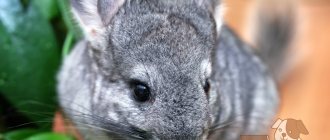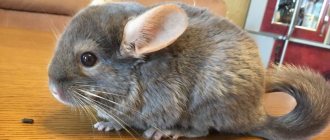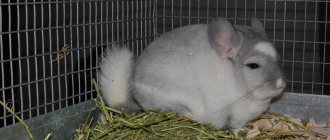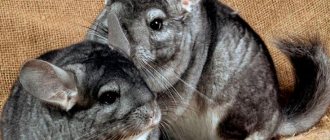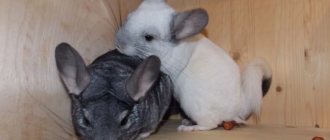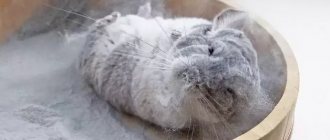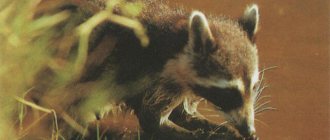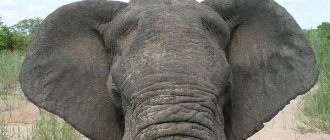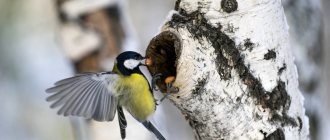- Wild animals
- >>
- Mammals
For many, such an interesting animal as the chinchilla is not at all a rarity; it has long become a common pet. This is no wonder, because these cute fluffy rodents are very attractive and cute. But chinchillas living in the wild are not easy to meet, because there are very few of these animals left, and they live only on one South American continent.
Origin of the species and description
Photo: Chinchilla
It is still unknown who the ancestor of the chinchilla is. Carrying out archaeological excavations in the Cordillera, scientists extracted from the bowels of the earth prehistoric fossils, which in their structure are very similar to chinchillas, only much larger in size. This animal, according to experts, lived forty thousand years ago, so the chinchilla genus is quite ancient. The Incas, many centuries ago, depicted chinchillas on rocks; this painting has survived to this day.
The Incas made various items of clothing from the soft skins of chinchillas, but among the Indians they were far from the first who were so attracted to the fur of rodents. The first who began to wear clothes made from chinchilla skins were the Indians from the Chyncha tribe. It is believed that the chinchilla got its name from them, because the word “chinchilla” itself is consonant with the name of an Indian tribe.
Video: Chinchilla
For the Incas, the value of chinchilla fur was very high; they maintained constant control over their production so as not to harm the animal population. But by the end of the 15th century the situation got out of control, because... The Spaniards who arrived on the mainland began a ruthless hunt for helpless rodents, which led to a rapid decrease in their numbers. The authorities of such South American countries as Chile, Bolivia and Argentina have banned the shooting of animals and their export, and introduced severe punishment for illegal hunting.
The chinchilla is a rodent from the chinchilla family of the same name.
These animals have two varieties:
- short-tailed chinchillas (coastal);
- Chinchillas are large, long-tailed (mountain).
Mountain chinchillas live at high altitudes (more than 2 km), their fur is thicker. This species is distinguished by a hump nose, which is designed for inhaling chilly mountain air. The coastal type of chinchillas is much smaller, but the tail and ears are much longer than those of mountain chinchillas. Officially, the short-tailed chinchilla species is believed to have disappeared completely, although local residents say they have been seen in remote mountainous areas of Argentina and Chile.
It is interesting that the first chinchilla farm was organized by the American Mathias Chapman, who brought the animals to the USA. He began to successfully breed chinchillas in order to sell their valuable fur; many then followed in his footsteps, organizing their own farms.
Historical facts about the origin of the chinchilla
Where exactly and from what animal chinchillas began their own origin is unknown. During excavations in the Cordillera, archaeologists discovered the ossified remains of the most ancient likenesses of animal species. Based on the type of genetic structure, they resembled the modern chinchilla. It should be noted that the prehistoric type of this animal was large in size.
In accordance with a rough estimate, the oldest animal, to which the found remains belong, lived about fifty years ago, therefore, the chronological information of these animals contains more than a thousand years.
The first literary mentions of the chinchilla family date back to the mid-sixteenth century. Fluffy lumps were mentioned in the work of a Spanish historian who sailed to South America with the conquistadors.
Appearance and features
Photo: Long-tailed chinchilla
Long-tailed chinchillas are very small, their body grows no more than 38 cm in length. The length of the tail varies from 10 to 18 cm. Long rounded ears reach 6 cm in height. Compared to the body, the head is quite large, the muzzle is round with cute large black eyes, the pupils of which are located vertically. The animal's whiskers (vibrissae) are long, reaching up to 10 cm; they are necessary for orientation in the dark. The weight of an adult rodent is less than a kilogram (700 – 800 g), the female is larger than the male.
The fur coat of the animals is pleasant, fluffy, soft, with the exception of the tail, which is covered with bristly hairs. The color of the fur is usually gray-blue (ashy), the belly is light milky in color. Other colors can be found, but they are rare.
A chinchilla has only 20 teeth, 16 of them are molars (they continue to grow throughout life). Compared to other numerous rodents, chinchillas can be called long-livers; these cute animals live up to 19 years. The chinchilla's paws are small, the animal has 5 fingers on the front limbs, and four on the hind limbs, but they are much longer. Pushing off with their hind legs, chinchillas perform long, deft jumps. The coordination of the animal can be envied; possessing a highly developed cerebellum, the chinchilla skillfully conquers rocky massifs.
An interesting biological feature of the rodent is its skeleton, which is capable of changing its shape (shrinking) if the situation requires it. At the slightest threat, a chinchilla will easily slip into even a tiny crevice. Also, one of the unique features is that the animal does not have sweat glands, so it does not emit any odor at all.
Chapman's contribution to animal breeding
Mathias F. Chapman , was the first to propose breeding rodents in captivity . In 1919, Chapman began searching for wild animals, which were extremely rare to see at that time. Over three years of searching, Chapman, with the help of 23 hired hunters, managed to catch 11 specimens. As it turned out later, out of the total number of animals, only three individuals turned out to be females. In 1923, Chapman, after much discussion, received permission from the Chilean government to export these animals outside the country.
After numerous studies and experiments, he managed to adapt the chinchillas to the usual lowland climate , and then transported them to San Pedro, California.
Where the first animal breeding farm was organized. His enterprise took off, and over the course of the twentieth century the animals spread throughout the globe. They began to be used not only for making clothes, rodents became decorative pets. Due to their good-natured and sympathetic disposition, they are the generally accepted favorites of all people in the world. But their wool began to be used much later.
The history of chinchillas has preserved this fact. Merchants sent jewelry to the Spanish queen as a gift, wrapped in a robe made of chinchilla wool. The Queen unwrapped the fabric and turned her attention to it. The high-ranking person was struck by the lightness and softness of the material that she did not even pay attention to the presented jewelry. The Spanish queen began to walk around the palace in this robe, and the nobles who noticed her new outfit sought to purchase similar material. .
Where does the chinchilla live?
Photo: Animal chinchilla
As already mentioned, the only continent where chinchillas are permanently registered in the wild is South America, or more precisely, the Andes and Cordillera mountain ranges. Animals are distributed from Argentina to Venezuela. The highlands of the Andes are the element of chinchillas, where they climb to heights of up to 3 km.
Little fluffies live in rather harsh, spartan conditions, where cold winds rage almost all year round; in the summer, the daytime temperature does not exceed 23 degrees plus, and winter frosts drop to -35. Rainfall in this area is very rare, so chinchillas avoid water procedures; they are completely contraindicated for them. After all, once wet, the animal will be chilled to the very bones. Rodents prefer to clean their coats by bathing in sand.
Typically, a chinchilla makes its lair in all sorts of small caves, rocky crevices, and between stones. Occasionally they dig holes in order to hide from various predatory ill-wishers. More often, chinchillas occupy abandoned burrows of other animals to live. In the wild, it is possible to meet a chinchilla with your own eyes only in Chile. In other countries there are so few of them that it is not possible to see rodents. And in Chile their population is under threat.
Care and maintenance of chinchillas at home
Raising chinchillas at home is no less popular than raising guinea pigs. First of all, your chinchilla will need a large cage. Ideally, the cage should be a tower type.
In this case, the optimal solution would be a display case for chinchillas, which will become an ideal home for the animal and will fit well into the home interior. A closet for chinchillas will satisfy all the needs of rodents. It has a house, stairs, floors, balconies, a running wheel and other toys. Moreover, such a display case is easier to remove than a cage.
Storing chinchillas requires maintaining a certain temperature. Chinchillas cannot tolerate heat, so the cage should be placed in a cool place without direct sunlight or drafts. The optimal temperature for chinchillas is +20-22°C. At temperatures of +25°C and above, the rodent will overheat. Never place the cage near a radiator.
The bottom of the cage should be lined with sawdust or special filler. The animal goes to the toilet anywhere, and it is very difficult to get a chinchilla that is used to defecating in one place. Bed linen should be changed at least once a week. The feeder and water bowl must be hung, otherwise the chinchilla may turn into a toilet.
Caring for your chinchilla at home also includes caring for its fur. Chinchilla fur gets dirty very quickly, so the animal requires frequent hygiene procedures. However, chinchillas do not bathe in water, but in special sand. Chinchillas will eagerly bathe in sand baths, with sand flying in all directions. Therefore, this procedure should be carried out outside the cage to prevent sand from collecting. The best solution in this case would be a round aquarium or other deep, stable, round-shaped container. Place it on the floor, place newspaper under it, apply a 5-6 cm layer of sand on the bottom and lead the animal there for 20-30 minutes.
A chinchilla should be bathed at least twice a week at home. If the humidity in the house is high and the temperature is close to +25°C, they should be washed 3 times a week. A bath is essential if you want your chinchilla to have beautiful fur. Don't forget that swimming in water is harmful to your chin and can cause health problems.
Also note that regular sand (sea, river) is not suitable for swimming. After all, in the wild, chinchillas bathe in volcanic ash, and not in sand. Therefore, you can only use special sand at home. In addition, regular sand can cause your pet to develop ringworm, parasites, or skin diseases. To prevent skin diseases, antifungal drugs can be added to special sand.
In general, caring for and breeding chinchillas at home does not require much effort. The main condition is to protect the animal from overheating and adherence to the correct feeding regimen. Try not to leave the animal unattended outside the cage.
Remember that rodents love to chew on everything, and furniture damage is guaranteed. The main danger is electrical wires. Also, do not forget that any hard-to-reach place in the apartment will be immediately explored by your curious pet.
Chinchilla maintenance and care, which is quite simple, has many advantages and one disadvantage. The advantages are the low cost of the animal, beautiful appearance, lack of odor and shedding, and calm character. However, the downside is its nocturnal lifestyle. If you decide to get such an animal, you will have to get used to its rustling, creaking and whining at night.
What does a chinchilla eat?
Photo: Chinchilla animal
The chinchilla's preference is plant food, which in the Andes mountains is quite scarce and monotonous.
The main rodent menu includes:
- herbs;
- small bush growth;
- cactus plants (succulents);
- mosses and lichens.
Animals receive moisture from dew and cactus plants, which are very juicy and fleshy. Chinchillas can eat the bark, rhizomes of plants, their berries, and do not disdain various insects. At home, the chinchilla menu is much more varied and tastier. People buy special grain feeds at pet stores. Animals love to eat not only fresh grass, but also various fruits, berries, and vegetables. Chinchillas will not refuse a crust of bread, dried fruits and nuts. Rodents eat hay in large quantities. The diet of chinchillas is very similar to the diet of hares or guinea pigs.
Under natural conditions, chinchillas do not experience any special problems with the intestines and stomach. Although they eat a large amount of green vegetation, some contain a lot of tannins, which help food to be digested normally. Scientists have noticed that in the mountains, next to chinchillas, chinchilla rats live, which make storage rooms with food in their burrows. Chinchillas also constantly use these reserves, eating the food of their prudent and thrifty neighbors.
Interesting Facts
Due to their small numbers and living in high mountain areas, chinchillas have not been studied as well as we would like. However, several interesting facts about these mysterious animals are still known. For example:
- The chinchilla body does not synthesize the enzyme that breaks down sucrose into simpler carbohydrates - glucose and fructose. Therefore, sweet and starchy foods are considered harmful to them.
- Female chinchillas have poorly developed parental behavior. They may leave the nest frequently and feed their young with milk for only 6-8 weeks. At the same time, until the new mother’s lactation normalizes, she does not try to feed the puppies at all. They literally run after her, trying to grab the nipple. Sometimes, in competition for mother's milk, stronger cubs kill weaker ones. Also, the chinchilla, unlike most other mammals, never drags its puppies to warmer and more protected conditions.
- In natural conditions, chinchillas never suffer from indigestion. The thing is that the alpine plants that fluffies eat contain astringents that strengthen the stool.
- Chinchillas are very hardy animals with good health. It has now been established that a healthy adult chinchilla can survive without food and water for 6-7 days. In this case, the animal will not lose weight and will not suffer complications from internal organs.
- Chinchillas are one of the few animals that do not shed seasonally. Also, their fur is hypoallergenic, and due to its high density, skin and blood-sucking parasites cannot live in it. Therefore, fluffies are ideal pets for allergy sufferers. However, sometimes chinchillas can still shed their fur - during stressful situations and when protecting themselves from enemies. The fluffy one easily throws off a clump of fur caught in the teeth of a predator and runs away for cover.
- In natural conditions, the chinchilla often uses one very original defensive reaction. If the animal has nowhere to hide from the enemy, it stands on its hind legs and, emitting a battle cry, literally bombards the predator with a powerful stream of urine.
Many owners of these cute animals have no idea where chinchillas live in the wild and know nothing about their range and habitat. However, this information is very useful - and not only for general development. After all, knowledge of the processes that occur with a chinchilla in natural conditions can help establish mutual understanding and trusting relationships with your pet in the shortest possible time.
Features of character and lifestyle
Photo: Big chinchilla
Not much is known about the temperament and life activity of chinchillas in natural conditions. Apparently because they are difficult to meet due to their small number. Many observations are made specifically on tamed animals living at home. Chinchillas are collective rodents; they live in packs, in which there are at least five pairs, and sometimes many more. This group life helps them better cope with various dangers and enemies. There is always an individual in the flock that observes the environment while others feed. At the slightest threat, this animal signals to others about the danger by making an unusual whistling sound.
Rodents are most active at dusk, when they emerge from their hiding places to explore areas in search of food. During the day, the animals almost never leave their holes and crevices, resting in them until the evening. Chinchillas' eyes are adapted to the dark and see just fine both at night and during the day. They are helped to navigate in space by their long and very sensitive whiskers, which, like navigators, direct them in the right direction, where food is available. Don’t forget about the big ears, which, like locators, pick up any suspicious sounds. The vestibular apparatus of animals is also well developed, so they easily overcome any mountain peaks and obstacles, moving quickly and deftly.
An interesting and unusual fact is that the head of the chinchilla family is always the female; she is the undisputed leader; it is not for nothing that nature has endowed her with larger dimensions compared to males.
Animals practically never see rain; in the regions where they live, such precipitation is very rare. Chinchillas bathe and clean their fur with volcanic sand, so rodents get rid of not only foreign odors, but also all kinds of parasites that live in their fur. An extraordinary feature of the chinchilla is the ability to shoot out its own fur, like a lizard with its tail. Apparently, this helps them in some situations to escape from predators. The predatory animal grabs the chinchilla’s fur, and a piece of it remains in its teeth, while the rodent runs away.
If we talk about the character of these sweetest creatures, it can be noted that domesticated chinchillas are affectionate and good-natured, and easily make contact with humans. The animal is very smart, it is easy to train it to the tray. Still, you can notice that chinchillas have a freedom-loving and independent disposition; you shouldn’t force the animal to do anything; it may get offended and not communicate. Rodents bite very rarely, only in extreme cases. Of course, each animal is individual, has its own characteristics and habits, and therefore the characters also differ.
Characteristic traits of character and habits
Each chinchilla has its own character and habits; even animals from the same litter do not have the slightest unity. Just like humans, animals have 4 character types.
Choleric
This is a nimble, agile and active animal. During the daytime he dozes forward, however, his sleep is light, and he can wake up from the slightest rustle. During the period of activity, the pet, with inquisitive behavior, studies the objects around it and everything that interests it. Cholerics are quite timid, and, if frightened, the animal will rush around a limited area, demolishing everything that comes across on the road.
Sanguine
A chinchilla that has this type of character is also active and curious, but is less timid and can react calmly to loud sounds and rustles. The animal does not like to be in one position for a long period of time; it walks around the premises with interest with the permission of the owner.
Phlegmatic person
The phlegmatic chinchilla is a calm and balanced pet. Throughout the day she stays in her own home, replacing active games with sweet sleep. Even when awake, the phlegmatic animal moves measuredly, with some laziness.
Social structure and reproduction
Photo: Chinchilla in nature
So, it was already said earlier that chinchillas are social animals that prefer to live in a group, in which they form their pairs. These rodents are monogamous, their unions are quite strong and long-lasting. The undisputed leading position in the family is occupied by the female. The female is ready for procreation already at six months of age, and males mature longer, becoming sexually mature only by 9 months. Chinchillas give birth several times a year (2 – 3).
The pregnancy period lasts for three and a half months. A pregnant female gains significant weight, and as birth approaches, she generally becomes inactive. Usually only one or two babies are born, very rarely – three. Tiny creatures that are already quite formed and look like their parents are born. From birth, the cubs already have a fluffy coat, sharp teeth and keen, curious eyes; they even know how to move.
Babies weigh from 30 to 70 g, it depends on how many of them were born. After just one week from the moment of birth, babies begin to try plant food, but continue to receive mother's milk until they are two months old. Chinchilla mothers are very caring and affectionate towards their children. These rodents are considered low-bearing, compared to their other relatives. In addition, the birth rate of young females is another 20 percent lower than that of experienced individuals. One chinchilla can usually give birth to up to 3 babies per year.
Veterinary
Fractures
Chinchillas lead active lives and can recover well from minor injuries. [24] Fractures can be problematic because chinchillas will want to sit on their hind legs and eat with their front legs, so many types of injuries disrupt their natural feeding behavior. [24]
Convulsions
Chinchilla breeders sometimes report that their animals experience seizures. This usually happens irregularly and only for a few seconds, but not more than a few minutes at most. [25] Seizures are a symptom that can have many causes, including brain problems such as bleeding, vitamin or nutritional deficiencies in the diet, or some type of damage to the nervous system. [25] If convulsions are observed after chinchillas have mated, it is possible that they are associated with a circulatory problem. [25] Some chinchillas housed in groups will experience stress seizures while feeding if they see other chinchillas getting food first. [26]Vitamin B, heart medications, or calcium injections may be used to prevent seizures. [25]
Infectious diseases
Standard domestic chinchilla
Listeriosis is not a typical chinchilla disease, but in group housing conditions it can spread in the community as a digestive tract disease. [27] Pasteurella
can become infected through food and then spread among a group of chinchillas.
[28] Symptoms include lethargy, indigestion, and fever. Pseudomonas aeruginosa
infections are widespread in nature and can affect chinchillas as well as many other animals. [30] They can cause death in chinchilla populations and spontaneous abortions in pregnant chinchillas. [thirty]
Respiratory tract infections can be caused by many pathogens but, regardless of the cause, usually result in difficulty breathing and nasal discharge. [31] Young chinchillas are more susceptible to infection, and these infections are unlikely to result in an epidemic even if they are contagious. [31]
Gastrointestinal disorders manifest themselves either as constipation or diarrhea. [31] They are almost always the result of a diet problem, but if the diet is optimal, they may be a symptom of an infectious disease. [32] Constipation in chinchillas is difficult to observe in groups because it may not be obvious that the animal is not contributing to the population's waste. [32] If found, gentle treatment includes feeding paraffin to soften the feces. [32]
Mental health
Chinchillas get upset easily, and when they are unhappy, they may exhibit physical symptoms. [33] Common signs of stress in pet chinchillas include fur chewing (or fur shaking), excessive grooming that results in uneven patches of fur; Chinchillas may chew their own fur or the fur of their cage mates. [34] Fur chewing can sometimes be alleviated by changing the environment, but some experts believe it is passed genetically from parent to offspring. [ citation needed
] Typically, wool chewing itself is a benign symptom that does not cause physiological distress. [35]
Sick chinchillas may stop eating when stressed, which can make them even weaker. [36] Chinchillas, which live in communities, are especially sensitive during the breeding seasons of February to March and August to September. [36] Chinchillas are social animals and are likely to become upset if they change their breeding partner during the breeding season. [36] They are known to be concerned about dietary changes during this time. [36]
Pharmaceutical treatment
Chinchillas can be treated with chloramphenicol, neomycin, or spectinomycin for digestive problems. [36] Sulfonamides dissolved in drinking water can be used. [37] Colistin may be an effective antibiotic. [37]
Natural enemies of chinchillas
Photo: Female chinchilla
Chinchillas have enough enemies in the wild, because every larger predator is not against eating such a small animal. Scientists single out the fox as the main enemy. This predator is much larger than a chinchilla and is very patient. A fox cannot get a chinchilla out of a narrow crevice or hole, but she can tirelessly wait for her prey at the entrance to her shelter for hours. In the wild, these rodents are saved by their camouflage coloring, excellent reaction speed, speed of movement and their compressible skeleton, thanks to which the rodents will penetrate any narrow gap where predators cannot get through.
In addition to the fox, the enemy of the chinchilla can be an eagle owl, an owl, a tayra, an owl, and a viper. Tyra is the most sophisticated enemy, she is similar to a weasel. This predator, having a resourceful body, can sneak right into a chinchilla’s hole or other shelter, catching the victim by surprise. Feathered predators can catch a chinchilla in an open, unprotected area.
Chinchillas have many ill-wishers, but the most merciless of them is the person who continues to poach, destroying cute little animals for their valuable fur coat.
In addition to all of the above, animals are negatively affected by the deterioration of the ecological situation, which is also associated with human activities.
Here you can name:
- soil contamination with chemical compounds;
- depletion of soil and food supply due to livestock grazing;
- disturbances in the atmosphere due to the release of greenhouse gases.
People sometimes think only about their own benefit and well-being, completely forgetting about their smaller brothers, who need, if not support, then at least human non-interference in their life activities.
Do chinchillas have intelligence?
Experts confidently call the soft lump an intelligent and quick-witted creature. Quite a large number of chinchillas can manipulate the owner themselves, in order to beg for a treat or to take a walk outside the cage.
Cunning pets use something that the owner cannot resist. This is an offended little face, which he eagerly rushes to please with a delicious treat or get out of the cage. Understanding this hobby of the owner, the chinchilla can put on a deliberately unhappy and distressed expression on his face to achieve his own goals.
Population and species status
Photo: Chinchilla
As scary as it sounds, the chinchilla population in the wild is in danger of extinction. There is disappointing data that over the past 15 years the animal population has decreased by 90 percent. In 2018, scientists counted only about 42 colonies living on the South American continent. They believe that this number of animals will not be enough for their population to increase in the future.
If you know how much a chinchilla fur coat costs, and this is more than $20,000, then it will become clear why this animal was so mercilessly exterminated. It is also necessary to take into account the fact that for one fur coat you will need at least 100 skins.
Europeans began trading chinchilla skins back in the 19th century. The fact that more than seven million skins were exported from the territory of Chile in the period from 1828 to 1916 is terrifying, and in total, 21 million animals were exported and destroyed. It’s scary to even think about such huge quantities! Measures were taken by the government only in 1898, when a ban on hunting and export was introduced, but apparently it was too late.
Chinchilla family
In this family of six species, three species of wild chinchillas are now distinguished. Now let's talk about each type in more detail and in order.
Royal chinchilla
In Latin: king of the chinchillas. This particular species was once called the chinchilla, and lived in the highlands of the Andes, in many South American countries, at altitudes of over 4,000 meters above sea level. The king chinchilla was the largest of all chinchilla species studied.
The body of the royal chinchilla was about 47 centimeters in length. The ears were larger and more rounded, and the tail was up to 8 centimeters. The royal chinchilla's tail seemed even longer because the tail was covered with long fur. Not only did the royal chinchilla's tail have long fur, but the entire body of this animal was covered with long fur of different colors.
Beginning in the 1500s, Spanish colonists hunted these wild chinchillas for their unusually thick and soft fur, and by 1800 the animals were no longer found in the wild. Today, only the stuffed royal chinchilla remains in the German Museum in Frankfurt am Main.
Short-tailed chinchilla
This is also called the large chinchilla. In Latin: chinchilla chinchilla. Formerly known as Chinchilla Brevicaudata. This type of chinchilla is the largest species and these animals can be found in mountainous areas. These chinchillas have a more rounded and massive body, gray thick fur and a short tail. Short-tailed chinchillas are known for their changeable temperament - they are very docile and affectionate.
Female short-tailed chinchillas bear their young a little longer than their long-tailed counterparts. Pregnancy in a short-tailed chinchilla lasts about 130 days. Female short-tailed chinchillas are less fertile than long-tailed chinchillas and give birth to one or two young.
Previously, this species inhabited almost the entire southern part of South America. Currently, the species is known only from a few individuals caught in 2001, and from observations made in 2011 in the National Park.
To this day, two species of chinchillas have survived in nature. These two species are sometimes very difficult to distinguish, as they share the characteristics of both species of short-tailed chinchillas. Much of the mixing of species is due to the domestication of these animals.
Long-tailed chinchilla
It is also called the small or regular chinchilla. In Latin, Chinchilla lanigera is the common chinchilla. Other names include coastal chinchilla or long-tailed little chinchilla, a species of rodent belonging to the chinchilla family. He is better known as our family pet.
Long-tailed and short-tailed chinchillas were once widespread in the wild along the central Andes and surrounding mountains. The ban on chinchilla hunting in 1929, unfortunately, only increased the demand for pelts. The long-tailed chinchilla was thought to be extinct in the wild, but was rediscovered in 1975.
Today, there are a few scattered colonies of long-tailed chinchillas in two separate locations, in northern and central Chile, although legislation to protect chinchillas dates back to 1929. Unfortunately, this law was not strictly enforced until 1983, when the Chinchilla National Refuge was created.
History of domestication
Under conditions of artificial breeding, chinchillas fare much better. Its cute appearance, unpretentiousness, good health and good-natured disposition have made this rodent very popular for home breeding and keeping. The first animals were domesticated at the beginning of the last century. American Mathias Chapman brought eleven individuals from Chile. All modern breeds and color morphs originate from them. Initially, chinchillas were bred only to obtain valuable fur.
By the middle of the last century, chinchilla farms appeared on all continents.
Breeders began to develop new color morphs - the genetics of the animals make it possible to obtain rodents with colors ranging from silver-white to jet-black. And already from the mid-80s of the last century, chinchillas began to gain popularity as pets.
Recommendations
- ^ abc Roach, N.; Kennerley, R. (2016). "Chinchilla chinchilla". IUCN Red List of Threatened Species
.
2016
: e.T4651A22191157. DOI: 10.2305/IUCN.UK.2016-2.RLTS.T4651A22191157.en. - ^ ab Woods, C. A., & Kilpatrick, C. W. (2005). Infraorder Hystricognathi
. In: D. E. Wilson and D. M. Reeder (eds.), Mammals of the World, pp. 1538–1599. Johns Hopkins University Press, Baltimore, Maryland, USA. - Jump up
↑ Chisholm, Hugh, ed.
(1911). "Chinchilla". Encyclopedia Britannica
.
6
(11th ed.). Cambridge University Press. paragraph 232. - ^ a b Patton, James L.; Pardiñas, Ulises F.J.; D'Elia, Guillermo (2015). Rodents. Mammals of South America. 2
. University of Chicago Press. pp. 765–768. ISBN 9780226169576. - ↑
Harding, Naomi (8 June 2016).
“Which land mammal has the thickest fur?” . animalanswers.co.uk
. Archived from the original on July 13, 2016. Retrieved April 16, 2022. - “What is a chinchilla?” . Davidson Chinchillas. Archived from the original on 2012-05-27. Retrieved February 1, 2008.
- "Chinchilla Facts - 10 Most Interesting Facts About Chinchillas". Chinchilla.co. Retrieved December 1, 2013.
- Jimenez, Jaime E. (1996). "Extirpation and current status of wild chinchillas Chinchilla lanigera and C. brevicaudata" (PDF). Biological conservation
.
77
(1): 1–6. DOI: 10.1016/0006-3207 (95) 00116-6. - "Everything you need to know about caring for chinchillas". Apbc.org.uk. Retrieved December 1, 2013.
- ^ ab "Chinchilla (Chinchilla lanigera)". Comparative collections of mammalian brains. Retrieved February 1, 2008.
- Chinchillas, Chinchillidae, Chinchilla lanigera, Chinchilla brevicaudata. Animal-world.com. Retrieved December 7, 2011.
- “Is a chinchilla a pet for me?” . Fantastic chinchillas. Archived from the original on January 12, 2008. Retrieved February 1, 2008.
- "Chinchilla Habitat". Chinchilla Chronicles
. Retrieved February 13 +2016. - "Chinchilla". Chinchilla Lexicon. 2003-05-01. Archived from the original on 2008-02-04. Retrieved February 1, 2008.
- "Short-tailed chinchilla". IUCN Red List of Threatened Species
. Retrieved November 15, 2022. - "Long-tailed chinchilla". IUCN Red List of Threatened Species
. Retrieved November 15, 2022. - Alderton, David. Rodents of the World
, 1996, p. 20. ISBN 0-8160-3229-7 - Chinchilla Endangered Species Directory Archived 2009-12-08 at the Wayback Machine. endangeredspecieshandbook.org. Retrieved December 7, 2011.
- "Teeth" . Homepage.ntlworld.com. Archived from the original on May 3, 2008. Retrieved July 30, 2009.
- Heatstroke . Chin-chillas.com. Retrieved December 7, 2011.
- Chinchillas: The Keystone Rodents! . Petstation.com (March 1, 1995). Retrieved December 7, 2011.
- Suckow, Mark A.; Stevens, Carla A.; Wilson, Ronald P. (2012). Laboratory rabbit, guinea pig, hamster and other rodents. Academic press. paragraph 949ff. ISBN 9780123809209.
- "In Scientific Research". University of Maryland, Baltimore County. Retrieved February 1, 2008.
- ^ a b Kraft 1987, p. 91.
- ^ a b c d Kraft 1987, p. 93.
- Jump up
↑ Kraft 1987, p. 94. - Jump up
↑ Kraft 1987, p. 98. - Jump up
↑ Kraft 1987, p. 99. - Jump up
↑ Kraft 1987, p. 100. - ^ a b Kraft 1987, p. 101.
- ^ abc Kraft 1987, p. 103.
- ^ abc Kraft 1987, p. 104.
- Jump up
↑ Kraft 1987, p. 111. - "Fur chewing". www.cuddlebugchinchillas.com
. Retrieved October 28, 2022. - "4 Things Chinchilla Owners Should Know About Fur Chewing - Choosing the Right Veterinarian for Your Pet". blackknightkennels.com
. Retrieved October 28, 2022. - ^ a b c d e Kraft 1987, p. 112.
- ^ a b Kraft 1987, p. 113.
Sources
- Kraft, Helmut (1987). Chinchilla diseases
. Translation by W. Erich Friese. Neptune City, NJ: TFH ISBN 978-0866224925. - Saunders, Richard. "Veterinary care for chinchillas." In Practice (0263841X)
31.6 (2009): 282–291.
Academic search completed
. Internet. April 19, 2016.
